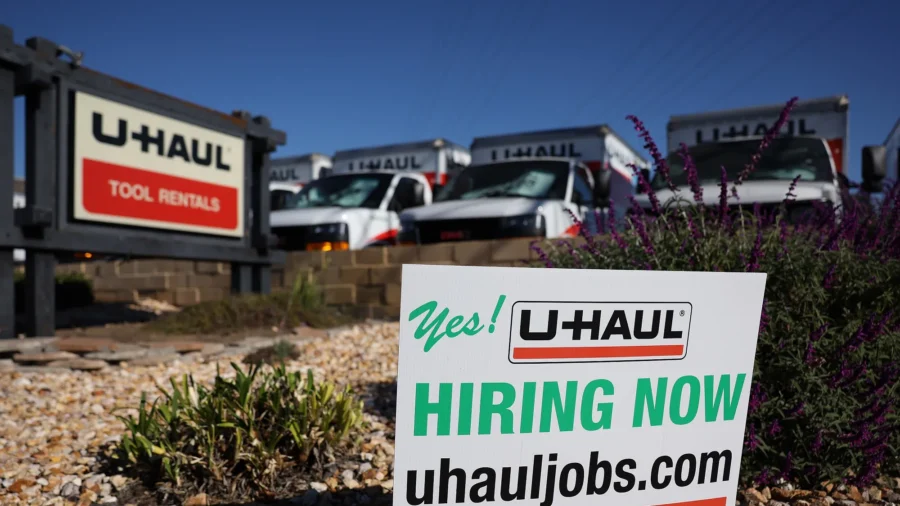In a fresh sign of labor market cooling, the number of job openings in the country has dropped to a two-and-a-half year low as America’s manufacturing sector extends its decline.
The Labor Department’s latest Job Openings and Labor Turnover Survey (JOLTS), released on Dec. 5, shows that job openings fell to 8.7 million as of the last day of October. This is the lowest level since March 2021 and well below market estimates of around 9.4 million.
“That’s a monthly decline of 617,000 jobs, a sharper-than-expected drop,” Mark Hamrick, senior economic analyst at Bankrate, told The Epoch Times in an emailed statement.
The number of job openings has been on a declining trend since hitting a record 12.0 million in March 2022. That’s when the Federal Reserve embarked on a feverish pace of raising interest rates in order to quash soaring inflation.
Economic activity has been cooling as higher interest rates crimp demand, with a number of economists expecting a recession next year. Fed officials, who hope to avoid a downturn and instead get an economic “soft landing,” have welcomed some loosening in the labor market.
Speaking during an event at Spelman College in Atlanta on Friday, Federal Reserve Chair Jerome Powell said “we are getting what we wanted to get” out of the economy.
A measure that Fed officials watch closely is the ratio of job openings to unemployed people. At the height of the job opening expansion in March 2022, this ratio stood at roughly 2, meaning two vacancies for every unemployed person.
The latest data show that, at the end of October, this ratio had dropped to 1.3, the lowest since mid-2021. Before the pandemic, this ratio was around 1.2, so the current level suggests the labor market is still somewhat tight—though continuing to unwind.
“Gradual loosening of the labor market continues,” analyst Charlie Bilello said in a post on X.
‘Better Balance’
The JOLTS report also showed that level of layoffs and discharges remained little changed at 1.6 million, while the rate remained unchanged from September at 1 percent.
The number of quits changed little at 3.6 million while the quits rate was unchanged at 3.6 percent for the fifth consecutive month.
Noteworthy over-the-month drops in hiring activity were in health care and social assistance (minus 236,000), finance and insurance (minus 168,000), and real estate and rental and leasing (minus 49,000). The number of job openings rose in information (39,000).
Overall, the latest JOLTS data is likely to be seen as a welcome sign by the Fed that its inflation-fighting rate hikes are filtering into the real economy and putting a dent in the job market.
“In the words of Federal Reserve officials, the supply and demand of labor is coming into better balance,” Mr. Hamrick said.
While the JOLTS figures point to ongoing cooling in the jobs market, other economic data on U.S. manufacturing painted a gloomy picture as the sector saw another month in recession territory.
Manufacturing Malaise
A recent run of economic data is flashing a warning sign for the U.S. economy.
New orders for American-made goods have suffered the sharpest drop in 3 1/2 years, with the latest sign of a slump in U.S. manufacturing adding to fears of a coming recession. According to the latest month of available data from the Commerce Department’s Census Bureau, factory orders fell 3.6 percent in October.
The decline is the sharpest monthly drop since April 2020, when pandemic lockdowns rattled the economy and threw it into a recessionary tailspin.
Also, the closely watched Institute for Supply Management’s Manufacturing PMI shows that U.S. manufacturing activity contracted in November for the 13th consecutive month, as demand softened and new orders fell.
The 13-monthlong U.S. manufacturing decline is the longest down streak since the 2008–2009 financial crisis. The manufacturing sector accounts for roughly 11 percent of the U.S. economy.
Also, a recent report from the Labor Department showed that initial claims for state unemployment benefits rose by 7,000 to 218,000 for the week ending Nov. 25, while the number of people receiving benefits after an initial week of aid (a proxy for hiring) rose to 1.927 million—the highest since November 2021.
Recession Coming?
Further, a key U.S. leading economic indicator from The Conference Board dropped for the 19th consecutive month in October.
“The Conference Board expects elevated inflation, high interest rates, and contracting consumer spending—due to depleting pandemic saving and mandatory student loan repayments—to tip the US economy into a very short recession,” Justyna Zabinska-La Monica, business cycle indicators senior manager at the Conference Board, said in a statement.
The Conference Board predicts that the U.S. economy will grow in 2024 by a paltry 0.8 percent.
Although gross domestic product grew by 5.2 percent, gross domestic income grew at a paltry 1.5 percent in the prior quarter.
“The key takeaway from this release is the economy likely is not humming the way media and [President Joe] Biden present,” analyst Mike Shedlock wrote in a blog post.
Recent data from October show that 69 percent of U.S. consumers expect a recession over the next 12 months, while a whopping 84 percent of C-suite executives believe a contraction will materialize.
“Further cooling in the job market is expected, but not a chill or a freeze, per se,” Mr. Hamrick said. “A soft landing appears to be the greatest likelihood for next year, while a mild and short recession can’t totally be ruled out.”
From The Epoch Times

